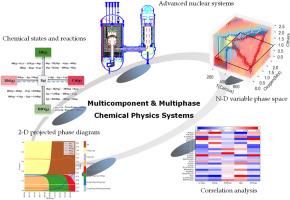Chemical states and reactions in multicomponent and multiphase systems containing different nuclide quantities
IF 3.2
3区 工程技术
Q1 NUCLEAR SCIENCE & TECHNOLOGY
引用次数: 0
Abstract
Nuclear energy systems are typically multicomponent and multiphase, containing a wide range of nuclides in different quantities, including major, minor and micro elements. In the primary circuit of a nuclear reactor, the fission and activation products generally fall into the micro element category. Investigating the chemical states and reactions of these micro elements presents a significant challenge. In this study, we propose a systematic approach to determining the chemical states and reactions in multicomponent and multiphase systems with varying nuclide quantities, based on fundamental physical principles. To demonstrate the applicability of this method, we utilized the primary circuit of a 10-MW high-temperature gas-cooled experimental reactor (HTR-10). The dominant chemical states of iodine in the primary circuit of HTR-10 were identified as CsI(g), HI(g), and RbI(g). Nine fundamental chemical reactions involving iodine were also identified. Furthermore, the results indicate that the major elements influence both the pressure and chemical potential of minor and micro elements, while minor elements can affect the chemical potential of micro elements. Additionally, the 2-D projected phase diagram developed in this study provides more comprehensive information than traditional 2-D phase diagrams, particularly regarding the relative quantities of components in complex systems.

含有不同核素量的多组分多相体系中的化学状态和反应
核能系统通常是多组分和多相的,包含大量不同数量的核素,包括主要、次要和微量元素。在核反应堆一次回路中,裂变和活化产物一般属于微量元素范畴。研究这些微量元素的化学状态和反应是一项重大挑战。在这项研究中,我们提出了一种基于基本物理原理的系统方法来确定具有不同核素量的多组分和多相系统中的化学状态和反应。为了证明该方法的适用性,我们利用了一个10mw高温气冷实验堆(HTR-10)的一次回路。HTR-10初级回路中碘的主要化学态为CsI(g)、HI(g)和RbI(g)。还确定了涉及碘的九种基本化学反应。结果表明,主元素对微量元素和微量元素的压力和化学势都有影响,微量元素对微量元素的化学势有影响。此外,本研究开发的二维投影相图提供了比传统二维相图更全面的信息,特别是关于复杂系统中组件的相对数量。
本文章由计算机程序翻译,如有差异,请以英文原文为准。
求助全文
约1分钟内获得全文
求助全文
来源期刊

Progress in Nuclear Energy
工程技术-核科学技术
CiteScore
5.30
自引率
14.80%
发文量
331
审稿时长
3.5 months
期刊介绍:
Progress in Nuclear Energy is an international review journal covering all aspects of nuclear science and engineering. In keeping with the maturity of nuclear power, articles on safety, siting and environmental problems are encouraged, as are those associated with economics and fuel management. However, basic physics and engineering will remain an important aspect of the editorial policy. Articles published are either of a review nature or present new material in more depth. They are aimed at researchers and technically-oriented managers working in the nuclear energy field.
Please note the following:
1) PNE seeks high quality research papers which are medium to long in length. Short research papers should be submitted to the journal Annals in Nuclear Energy.
2) PNE reserves the right to reject papers which are based solely on routine application of computer codes used to produce reactor designs or explain existing reactor phenomena. Such papers, although worthy, are best left as laboratory reports whereas Progress in Nuclear Energy seeks papers of originality, which are archival in nature, in the fields of mathematical and experimental nuclear technology, including fission, fusion (blanket physics, radiation damage), safety, materials aspects, economics, etc.
3) Review papers, which may occasionally be invited, are particularly sought by the journal in these fields.
 求助内容:
求助内容: 应助结果提醒方式:
应助结果提醒方式:


